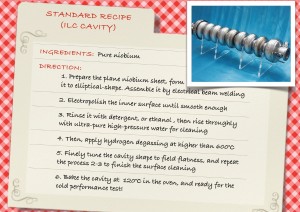The term cavity gradient is used to describe the electric field that accelerates a particle. This reflects the most basic purpose of each cavity. “What you want out of a cavity is to give a particle more energy than it had before,” says Fermilab physicist Andy Hocker. Cavity gradient determines the rate of this change: the increase in energy with distance as it passes through the cavity.
At the ILC, the goal is for particles to enter one end of an accelerating cavity and emerge from the other having gained more than 32 million electron volts of energy. The change is sometimes illustrated with a graph. On the y-axis is the energy of particles and on the x-axis, distance. The resulting picture looks like a ramp: As the particles pass through the cavity, their energy increases.
 Gradient is based on both the cavity’s design and how much power is put into the cavity. Therefore, this variable is not a characteristic of the cavity itself but a function of how the cavity is operated: put more radiofrequency power into a cavity and increase its gradient . The cavity gradient at the ILC will reach 31.5 million volts per metre. This is a very high gradient, which means fewer cavities will be needed and the accelerator can be more compact. However, these gradients do have limits based on the cavity’s quality factor and quenching limitations.
Gradient is based on both the cavity’s design and how much power is put into the cavity. Therefore, this variable is not a characteristic of the cavity itself but a function of how the cavity is operated: put more radiofrequency power into a cavity and increase its gradient . The cavity gradient at the ILC will reach 31.5 million volts per metre. This is a very high gradient, which means fewer cavities will be needed and the accelerator can be more compact. However, these gradients do have limits based on the cavity’s quality factor and quenching limitations.

Recent Comments